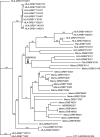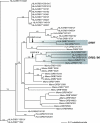Impact of endogenous intronic retroviruses on major histocompatibility complex class II diversity and stability
- PMID: 18448532
- PMCID: PMC2447082
- DOI: 10.1128/JVI.00097-08
Impact of endogenous intronic retroviruses on major histocompatibility complex class II diversity and stability
Abstract
The major histocompatibility complex (MHC) represents a multigene family that is known to display allelic and gene copy number variations. Primate species such as humans, chimpanzees (Pan troglodytes), and rhesus macaques (Macaca mulatta) show DRB region configuration polymorphism at the population level, meaning that the number and content of DRB loci may vary per haplotype. Introns of primate DRB alleles differ significantly in length due to insertions of transposable elements as long endogenous retrovirus (ERV) and human ERV (HERV) sequences in the DRB2, DRB6, and DRB7 pseudogenes. Although the integration of intronic HERVs resulted sooner or later in the inactivation of the targeted genes, the fixation of these endogenous retroviral segments over long time spans seems to have provided evolutionary advantage. Intronic HERVs may have integrated in a sense or an antisense manner. On the one hand, antisense-oriented retroelements such as HERV-K14I, observed in intron 2 of the DRB7 genes in humans and chimpanzees, seem to promote stability, as configurations/alleles containing these hits have experienced strong conservative selection during primate evolution. On the other hand, the HERVK3I present in intron 1 of all DRB2 and/or DRB6 alleles tested so far integrated in a sense orientation. The data suggest that multigenic regions in particular may benefit from sense introgressions by HERVs, as these elements seem to promote and maintain the generation of diversity, whereas these types of integrations may be lethal in monogenic systems, since they are known to influence transcript regulation negatively.
Figures






Similar articles
-
Evolution of HLA-DRB genes.Mol Biol Evol. 2012 Dec;29(12):3843-53. doi: 10.1093/molbev/mss186. Epub 2012 Jul 23. Mol Biol Evol. 2012. PMID: 22826457 Free PMC article.
-
Primate DRB genes from the DR3 and DR8 haplotypes contain ERV9 LTR elements at identical positions.Immunogenetics. 1995;41(2-3):74-82. doi: 10.1007/BF00182316. Immunogenetics. 1995. PMID: 7806299
-
Expansion and contraction of rhesus macaque DRB regions by duplication and deletion.J Immunol. 1994 Mar 1;152(5):2298-307. J Immunol. 1994. PMID: 8133043
-
Exonic MHC-DRB polymorphisms and intronic simple repeat sequences: Janus' faces of DNA sequence evolution.Immunol Rev. 1995 Feb;143:199-224. doi: 10.1111/j.1600-065x.1995.tb00676.x. Immunol Rev. 1995. PMID: 7558077 Review.
-
On the classification and evolution of endogenous retrovirus: human endogenous retroviruses may not be 'human' after all.APMIS. 2016 Jan-Feb;124(1-2):44-51. doi: 10.1111/apm.12489. APMIS. 2016. PMID: 26818261 Review.
Cited by
-
Trans-species polymorphism, HLA-disease associations and the evolution of the MHC.Commun Integr Biol. 2009 Sep;2(5):408-10. doi: 10.4161/cib.2.5.8765. Commun Integr Biol. 2009. PMID: 19907702 Free PMC article.
-
Horizontal gene transfers with or without cell fusions in all categories of the living matter.Adv Exp Med Biol. 2011;714:5-89. doi: 10.1007/978-94-007-0782-5_2. Adv Exp Med Biol. 2011. PMID: 21506007 Free PMC article. Review.
-
Differential recombination dynamics within the MHC of macaque species.Immunogenetics. 2014 Oct;66(9-10):535-44. doi: 10.1007/s00251-014-0783-4. Epub 2014 Jun 17. Immunogenetics. 2014. PMID: 24934118 Free PMC article.
-
MHC class I diversity of olive baboons (Papio anubis) unravelled by next-generation sequencing.Immunogenetics. 2018 Jul;70(7):439-448. doi: 10.1007/s00251-018-1053-7. Epub 2018 Feb 24. Immunogenetics. 2018. PMID: 29478145 Free PMC article.
-
Antagonistic Coevolution of MER Tyrosine Kinase Expression and Function.Mol Biol Evol. 2017 Jul 1;34(7):1613-1628. doi: 10.1093/molbev/msx102. Mol Biol Evol. 2017. PMID: 28369510 Free PMC article.
References
-
- Andersson, G., D. Larhammar, E. Widmark, B. Servenius, P. A. Peterson, and L. Rask. 1987. Class II genes of the human major histocompatibility complex. Organization and evolutionary relationship of the DR beta genes. J. Biol. Chem. 2628748-8758. - PubMed
-
- Andersson, G., A. C. Svensson, N. Setterblad, and L. Rask. 1998. Retroelements in the human MHC class II region. Trends Genet. 14109-114. - PubMed
-
- Antony, J. M., K. K. Ellestad, R. Hammond, K. Imaizumi, F. Mallet, K. G. Warren, and C. Power. 2007. The human endogenous retrovirus envelope glycoprotein, syncytin-1, regulates neuroinflammation and its receptor expression in multiple sclerosis: a role for endoplasmic reticulum chaperones in astrocytes. J. Immunol. 1791210-1224. - PubMed
-
- Arvidsson, A. K., A. C. Svensson, E. Widmark, G. Andersson, L. Rask, and D. Larhammar. 1995. Characterization of three separated exons in the HLA class II DR region of the human major histocompatibility complex. Hum. Immunol. 42254-264. - PubMed
Publication types
MeSH terms
Substances
Associated data
- Actions
Grants and funding
LinkOut - more resources
Full Text Sources
Research Materials

